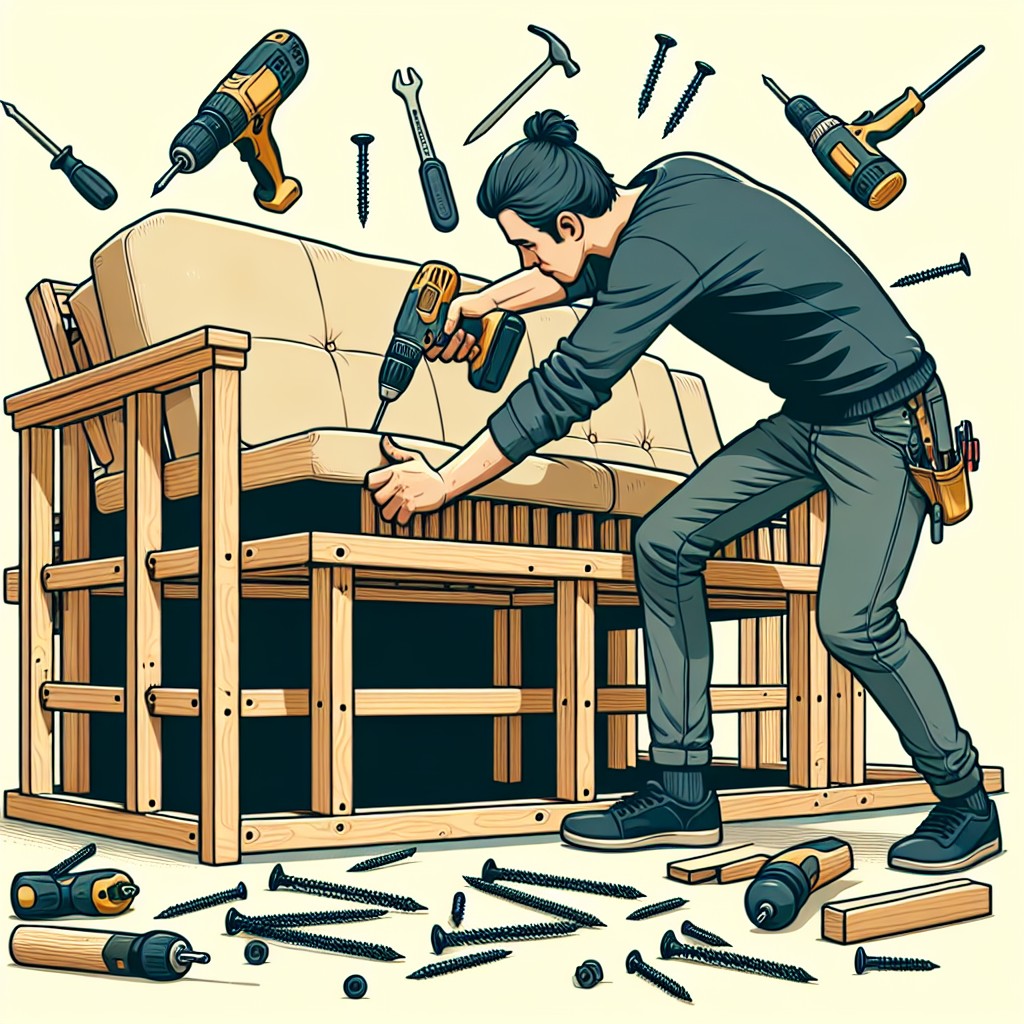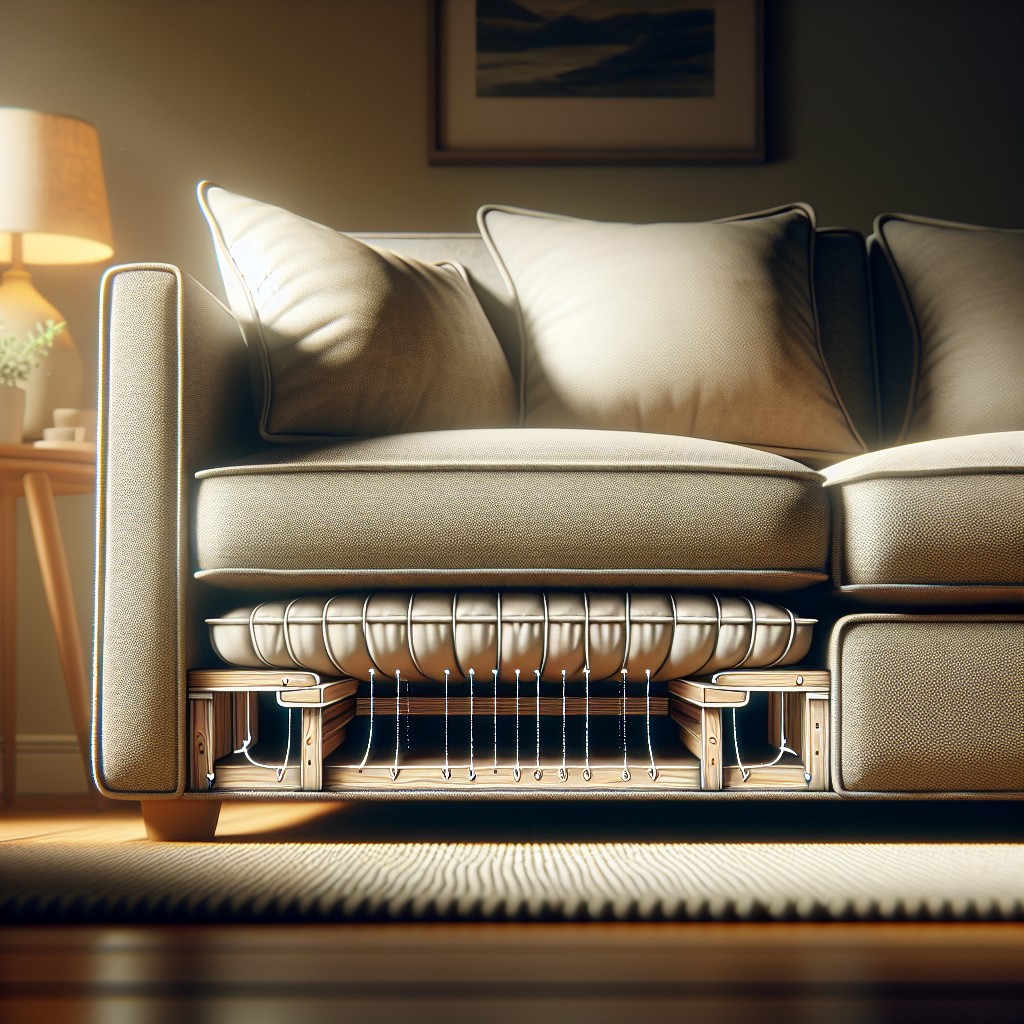Last updated on
Do you have a sagging couch in your home? Want to fix it yourself and avoid the hefty repair costs? This guide will help you do it.
Couch sagging can be quite a nuisance, but with the right approach, you can make it a thing of the past. Whether it’s the result of prolonged use or insufficient support, it’s crucial to tackle this issue head-on.
I made this guide right after I cut down my old couch into pieces and took it to the recycling center. It was beyond fixing, and I’ve tried it all. So, I know a thing or two about what you can do to save your couch before sending it off to couch heaven.
This guide will walk you through a simple yet effective method to rectify this: by redistributing the stuffing, adding plywood reinforcements, or replacing the foam. The instructions provided here encompass all you need – clear, straightforward, and practical steps – for a sag-free couch experience.
This is indeed the ultimate guide that promises to bring back the comfort and elegance your couch once had. So, grab that toolbox, and let’s get started!
Key takeaways:
- Understanding the reasons for sagging.
- Evaluating and flipping/rotating cushions.
- Adding extra stuffing to cushions.
- Fixing frame issues and inspecting springs.
- Replacing cushions or seeking professional help when needed.
Table of Contents
Understanding the Reason for the Sag

Sagging is typically triggered by several factors. Frequently, it’s a natural effect of extended use or age, contributing to wear and tear on both the frame and cushions. Additionally, quality plays a role in the longevity of couches; lower quality sofas are structured using less-durable materials which may result in premature sagging. Weight distribution is another prominent factor, as consistently applying pressure to the same area inevitably leads to dips and sags. Therefore, periodically rotating seat cushions can help to maintain their shape.
Last but not least, if your couch is stored in a damp environment, moisture can seep into the cushioning and frame, causing them to weaken and sag over time.
How to Repair a Sagging Couch Yourself
So you have that sagging couch and you are sure you can repair it yourself. Indeed, hiring a repairman or taking it to a repair shop is a costly and time-intensive matter. The DIY way is much more efficient. But that’s only if you know what you’re doing.
What Do You Need to Check First?
- What’s broken? Is it the frame, the springs, or just the cushions.
- Take off the cushions off the couch first and turn it over to find out.
- Is it just the sagging cushions?
- Can you see any broken or cracked wood in the frame?
- Are there any bent springs?
How to Fix It?
- Cushions are easy to fix and you can do it yourself easily. You just need to add replacement filling and batting.
- Broken parts of the wooden frame will need to be replaced. This involves woodworking. In some cases, you can fix it with metal brackets.
- To fix springs you will need special tools or to take it to a specialist.
We will go over each of the above points in this article next.
Evaluating the Couch Cushions

Start by giving cushions a thorough inspection, focusing on the fill material. Foam-filled couch cushions tend to lose their firmness over time, resulting in a saggy appearance. If they feel lumpy or noticeably softer compared to when new, it could be a sign of degradation, and replacing the foam inserts may help.
Meanwhile, down-filled cushions often require simply fluffing and shifting the stuffing to restore their shape, though sometimes you might need to add more down.
Don’t forget about the cushion covers; they should fit snugly around the fill material. Loose covers can make a couch appear saggy, even if the cushions are in good shape.
Understanding the state of your cushions is crucial in your pursuit of a firm and comfortable couch. Should you find a major problem like tearing, fraying, or extreme thinning of fabric, consider getting professional help or look for replacement options.
Flipping and Rotating Cushions

Even the most high-quality cushions can develop uncomfortable dents and contours over time due to frequent use. By flipping and rotating, these imprints can be made less noticeable and the life of the cushion can be extended.
Here are some simple steps to carry out this procedure effectively:
- Remove the cushions from the couch and note the areas of most depressions.
- Rotate each cushion 180 degrees. This means, if the right side was against the armrest, it should now be on the side touching the middle of the couch.
- Similarly, flip the cushions upside-down so the top side is now at the bottom.
- Gently pat the cushions a few times before returning them to the couch. This helps redistribute any displaced filling material inside.
- Repeat this process every few months or as soon as you notice a dip forming again.
Remember, these steps work best when practiced regularly to prevent significant sagging.
Adding Extra Stuffing to Cushions

For cushions that have lost their firmness, adding extra stuffing can be an effective solution. Opt for high density foam or poly-fiber fill, both of which are durable and known for their ability to regain shape after use.
- Remove the cushion from the couch, unzipping or unstitching the cover if required.
- Note the existing material and its arrangement. This serves as a guide when adding new stuffing material.
- Cut or prepare your chosen stuffing material to fit, remembering to slightly overstuff to account for settling over time.
- Once filled, ensure even distribution of stuffing by manually adjusting from the outside of the cushion.
- Reattach or zip the cushion cover back on, taking care to ensure a smooth and even finish.
Adding extra stuffing is a way to restore volume and shape, enhancing both the comfort and appearance of your couch. Be mindful not to overstuff the cushion, which can cause bumps or lumps. Rather, aim for a well-stuffed, smooth, and comfortable cushion.
Figuring Out the Frame Issues

Foremost, inspect the couch’s frame for any warping or breakage. High-quality sofas usually have frames made of solid hardwood, which is less prone to warping or breaking compared to softer woods. However, with time and continued use, even the best frames can succumb to wear and tear.
Identify the issue, then utilize wood glue to repair small cracks, allowing them to dry as directed on the bottle. Alternatively, use clamps to keep everything in place for more severe warping or breaking. Remember, you might also need screws and brackets for a more secure hold on significant breaks on the frame.
Still, for instances where the frame is severely damaged, it may be more cost-effective and less time-consuming to replace the entire couch. Sometimes extensive repairs could end up costing more than a brand-new quality couch.
Examining Springs for Damage

First, locate the zigzag or sinuous springs. They’re easy to identify because they loop back and forth across the couch’s frame. Inspect these carefully for any signs of wear or tear, such as rust, discoloration, or an obvious bend or break in the metal.
To test the spring’s sturdiness, press down on it. A functioning spring should bounce back quickly. If it feels loose, it may need tightening. Be especially cautious if a spring does not return to shape or doesn’t offer resistance when pressed. This could be a clear sign of damage that might require replacement.
Secondly, look for coil springs which are typically found on older couches. Like mattress coils, they’re round and individually encased. If these are worn out or bent, you’ll want to consider replacing them as they could be the cause of your sagging problem.
Remember, safety is paramount when handling these components due to their tension. In case you’re not confident in handling the task, don’t hesitate to consult a professional.
Repairing or Replacing Couch Springs

With time, springs can wear out or break, leading to a sagging couch. If the problem’s root lies here, start by removing the bottom cloth cover of the couch. Use needle-nose pliers to remove any broken springs.
Replacement springs can be found online or in local furniture stores. When buying new springs, ensure they match the size and tension of your existing ones. Thread them into their correct spots, using clamps to hold them in place. Once all new springs are in place, staple the bottom cloth cover back onto the couch.
Before moving onto the next step in the process, test the couch for a comfortable and even firmness. If the sag persists, there may be further issues at hand, such as a faulty frame.
Fixing the Frame of the Couch

Once the reasons for the sag have been investigated, it’s time to work on rectifying frame issues. Begin by flipping the couch to expose the underside. Use a flashlight to locate any noticeable cracks, splits, or signs of wear. However, often, the problem may just be loose or missing screws.
Collect the required repair tools such as wood screws, a drill, and wood glue. If the frame has minor cracks or gaps, apply wood glue, let it dry, then reinforce with wood screws. For broken sections, it’s ideal to replace them entirely; procure a new wooden piece similar in size and attach it using the same process.
Remember, tighten all loose joints and screws to ensure the stability of the frame. Be sure not to over-tighten, as this could lead to further damage. Always pay attention to safety precautions while working with tools to prevent injuries. After these steps, your couch frame should be sturdy and ready to offer ample support once more.
Checking the Support System of the Couch

To identify whether the support system is the issue, locate the beams running underneath the couch. These provide necessary structure and durability. Should they be showing any sign of damage or wear, consider replacing or reinforcing them.
Materials you will likely need include wood of similar dimension to your original beams, woodworking tools like saws and drills, and sturdy screws for attachment.
Remember, precision is key when it comes to replacements or reinforcements. Misalignments can lead to further damage or discomfort. If woodworking isn’t your forte, consider involving a professional to ensure the job gets done right.
Another point to consider is loose or broken joints. They can be the hidden culprit behind a saggy couch. For loose joints, some wood glue can help, while broken joints may require more substantial repair or replacement.
Finally, worn out webbing or broken springs can compromise the support system. Should any issue persist after addressing beams and joints, delve deeper into these potential causes. They can require a bit more effort to fix, but the pay-off? A practically new-again couch, quickly becoming your favorite spot to settle down.
Replacing Couch Cushions If Needed

While repairs can work wonders, there are times when replacement is the best option. A frayed, torn, or badly worn cushion cover might warrant a new one, especially if it compromises the comfort or aesthetic.
Choose a quality replacement that matches your couch style. Consider factors such as foam density and durability. If unsure, consult with a furniture expert for guidance.
High-resilience (HR) foam is considered good quality, offering long-lasting support and comfort. Try to stick to a density rating of 1.8 lbs/ft³ or higher and compression of 35 or higher for optimal longevity.
Remember that investing in a good quality cushion can save future repair costs and ensure the comfort of your couch.
How to Fix a Sagging Couch with Plywood
Using a board of plywood is a great quick fix to your sagging couch if the frame is weak or broken. Keep in mind though, that it’s more of a temporary fix and you will need to fix the actual frame later.
Plywood adds support for the cushions but it makes them a lot firmer too. This might be not what you want.
To fix sagging cushions with plywood, you will need to take out the cushions. Take measurement of the area of the couch for which the wood is needed. Cut the plywood, slide it in, replace the cushions and enjoy.
Tips to Prevent Future Sagging

Regular maintenance can help in thwarting the likelihood of a sagging couch. Avoid putting excessive weight on the cushions. If possible, do not sit in the same spot repeatedly as this contributes to uneven wear and sagging.
Flipping and rotating the cushions monthly will promote even wear and prolong their lifespan. If your couch is frequently used, opt for high-density foam when replacing the cushion filling as this tends to retain its shape longer.
Lastly, avoid jumping on the couch, especially the armrests and backrest, to maintain the structural integrity of the frame.
Tools and Materials Needed for the Repair Process

Start with a sturdy pair of needle-nose pliers, useful for pulling out and repositioning any misbehaving springs. A staple gun is necessary for affixing new fabric or re-securing old, and don’t forget staples.
A screwdriver set will help with frame repairs, while pliers or a wrench may be needed to tighten any loose nuts or bolts.
If your cushions require additional stuffing, have foam, poly-fil, or down feathers on hand, depending on the original material. Measure your cushions before purchasing to estimate the amount needed.
Finally, a sewing kit can manage minor fabric repairs or stitch closed cushions after restuffing. For larger fabric repairs, consider a heavy-duty sewing machine.
Remember, safety comes first: have gloves for handling sharp tools, eye protection when dealing with springs, and clear your workspace to prevent accidents. Always use tools as directed by their manufacturer.
Accessing the Inside of the Couch for Repair

To begin the process, locate the fabric attached to the base of the furniture called the dust cover. With your hands or a pair of pliers, gently remove the staples or nails attaching this fabric to the frame. Once removed, you’ll see the inner workings of the couch, including the springs and frame.
It’s crucial not to damage the dust cover, as it will be reattached later. For easy access to the inside, you might need to flip the couch upside down or onto its side. Be mindful of the weight to avoid injury.
Now, you can clearly see the issue – be it broken springs, insufficient padding, or weak support system. Ensure to handle all components with care to avoid causing further harm.
Remember, safety first. Always use gloves and protective eyewear when handling sharp objects like staples, nails, or damaged springs. To make the job easier, consider using tools like a staple remover, a hammer, screwdrivers, and a powerful flashlight for better visibility.
Understanding When Professional Help Is Needed

When considering the extent of couch sag, serious cases may require more than at-home remedies. If the sagging continues even after applying the above-mentioned fixes, there could be a deeper problem. For instance, it may be a major frame issue, a problem with the coil springs, or the need to completely replace the cushioning. These repairs might necessitate specialized tools and expertise.
Here are signals hinting you might need a furniture repair expert:
- Loft or cushion filler is no longer springy and fails to bounce back.
- The frame presents severe, visible damage.
- Springs are broken, not just loose or stretched.
- Sagging continues after exhausting all DIY methods.
Additionally, for antique or expensive furniture, it’s always recommended to call in professionals to ensure a high-quality fix that extends the life of the piece. Don’t risk further damage by attempting more complex repairs if it’s beyond your skill set.
FAQ
Can a sagging sofa be repaired?
Yes, a sagging sofa can be repaired by replacing the cushion filling with higher-density foam and batting or adding a piece of plywood between the couch frame and the cushions for extra support, unless the cushions are permanently attached.
How do I stop my couch from sinking in the middle?
To address a couch sinking in the middle, either cut a piece of plywood to fit the under-cushion area or purchase a premade panel specifically designed for this purpose which will firm up the seating area and solve the sinking issue.
How do you bolster a sagging couch?
Bolstering a sagging couch can be achieved by adding more stuffing to the cushions, inserting additional foam evenly, or replacing worn out foam, and if the cushions are filled with loose stuffing, they can be stuffed further using polyester fiberfill.
Do sofa support boards work?
Yes, sofa support boards work effectively as they prevent sagging or damage to the base of your sofa by providing sturdy reinforcement.
What are some cost-effective fixes for a sinking couch?
Some cost-effective solutions for a sinking couch include replacing the old, worn-out foam in the cushions, using plywood or a sagging sofa support under the cushions, or investing in a sofa saver board for added support.
Can I use plywood to support a sagging sofa?
Yes, appropriately measured and cut plywood can be used to support a sagging sofa, as it adds firmness and prevents further sagging.
How does couch frame repair aid in correcting a slouching sofa?
Couch frame repair aids in rectifying a slouching sofa by strengthening weakened joints and replacing broken or worn-out parts, thereby restoring its original structure and comfort.





